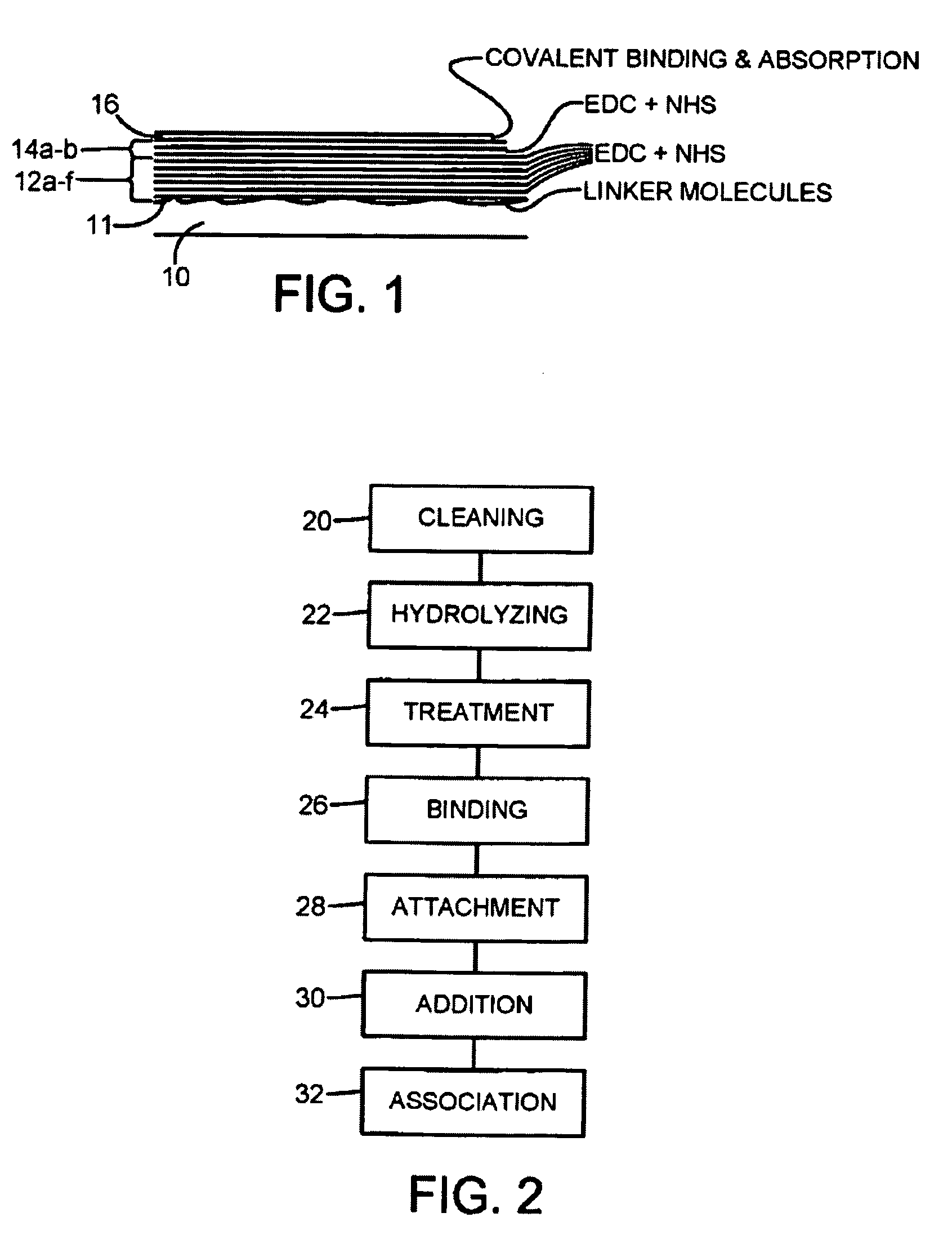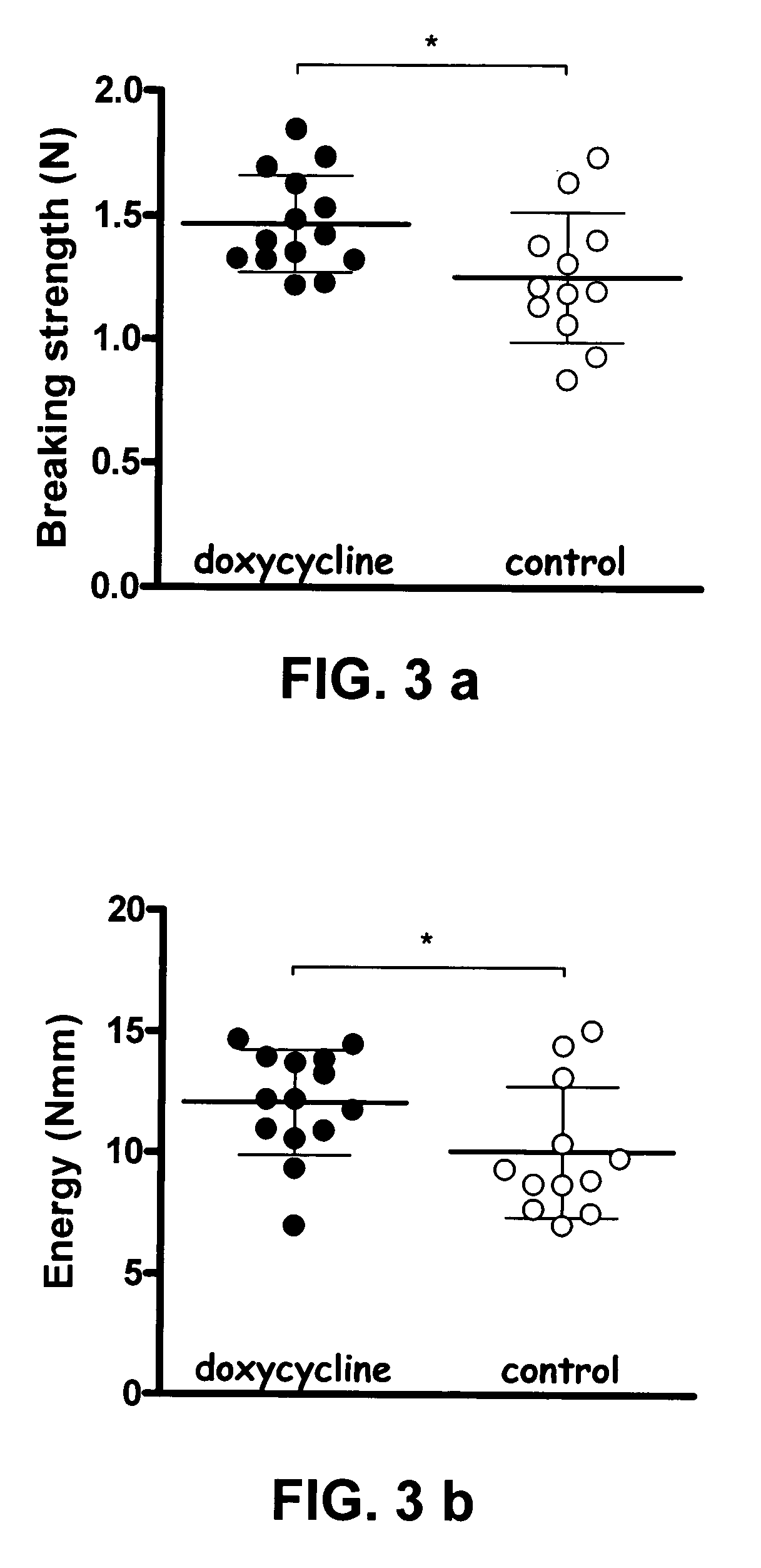Coated suture thread and production thereof
a technology of suture thread and coating, applied in the field of coating suture thread, can solve the problems of high risk that the suture thread will cut through the tendon material, breakage of tissue, and softening of the tissue around the sutur
- Summary
- Abstract
- Description
- Claims
- Application Information
AI Technical Summary
Benefits of technology
Problems solved by technology
Method used
Image
Examples
example 1
Coating of Suture Material with EDC / NHS Crosslinked Fibrinogen and MMP-Inhibitor
[0049]Suture materials made of e.g. polyamides such as nylon-6,6 and nylon-6, or poly(p-dioxanone) or polylactide / -glycolide, are cleaned according to standard laboratory practice for 10 minutes by incubation in 70% ethanol followed by copious rinsing in distilled water and dried in nitrogen gas followed by 30 seconds exposure to UV. The structure surfaces become hydrolyzed during typically 3 hours in distilled water and treated one minute in a Radio Frequency Plasma chamber. Radio frequency plasma treatment roughens the surface of the suture material and generates charged and chemically reactive surface groups onto which for example spacers or proteins can be covalently attached. For example, surface carboxyl or amine groups may be formed on the suture via the surface activation procedures.
[0050]Thereafter, a linker molecule such as glutaraldehyde or ethyl-dimethyl-aminopropylcarbodiimide (EDC) is bound...
example 2
Alleviation of Postoperative Weakening of Sutured Intestinal Tissue by Use of a Matrix Metalloproteinase Inhibitor Coating on Sutures
[0054]Doxycycline was used in the experiment as MMP inhibitor for local delivery at the suture site since several experimental studies have shown beneficial effects of treatment with systemic MMP-inhibitors, e.g. doxycycline, most notably on the critical third postoperative day7,8.
Materials and Methods
Suture Coating
[0055]Sterile 6-0 polybutester monofilament sutures (Novafil, Tyco Healthcare, Schaffhausen, Switzerland) were activated during 10 seconds on each side in a radio frequency plasma chamber (Plasmaprep 100; Nanotech, Sweden). The activated sutures were incubated for 30 minutes in 6% glutaraldehyde in phosphate buffered saline (PBS), pH 9. The surfaces were extensively rinsed in PBS, pH 9. Ten layers of fibrinogen (HYPHEN BioMed, Neuville-sur-Oise, France; molecular weight: 340 kDa, clotability 98%) were prepared as follows9: the glutaraldehyde...
example 3
Improved Tendon Suture Fixation by Use of a Matrix Metalloproteinase Inhibitor Coating on Sutures
[0068]The effect of the MMP-inhibitor doxycycline on tendon suture fixation is evaluated in this experiment. First the effect of systemic doxycycline was examined. Then, doxycycline was applied locally, by using a coating comprising doxycycline on the suture material. Systemic and local doxycycline treatment were evaluated regarding suture pull-out strength in the rat Achilles tendon.
Materials and Methods
Systemic Treatment
[0069]40 male Sprague Dawley rats weighing 405 (SD 24) g were randomised to receive deionised drinking water with or without doxycycline 80 mg / kg / day, which gives a clinically relevant serum concentration. Suture fixation was evaluated 3 days after operation.
Local Treatment
[0070]A nylon suture was coated with doxycycline hyclate (4 nm, Sigma) on top of EDC / NHS crosslinked fibrinogen (30 nm, Haemochrom Diagnostica). The total amount of immobilized drug was approximately ...
PUM
| Property | Measurement | Unit |
|---|---|---|
| thickness | aaaaa | aaaaa |
| pH | aaaaa | aaaaa |
| thickness | aaaaa | aaaaa |
Abstract
Description
Claims
Application Information
 Login to View More
Login to View More - R&D
- Intellectual Property
- Life Sciences
- Materials
- Tech Scout
- Unparalleled Data Quality
- Higher Quality Content
- 60% Fewer Hallucinations
Browse by: Latest US Patents, China's latest patents, Technical Efficacy Thesaurus, Application Domain, Technology Topic, Popular Technical Reports.
© 2025 PatSnap. All rights reserved.Legal|Privacy policy|Modern Slavery Act Transparency Statement|Sitemap|About US| Contact US: help@patsnap.com



